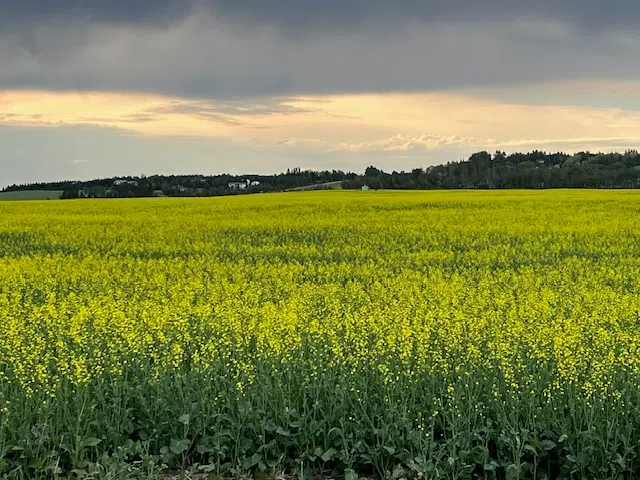As of June 30, crops are being reported in good to excellent condition in the North West Region at 77 per cent for major crops, and 78 per cent for all crops.
That’s according to the latest crop report from Agriculture Financial Services Corporation (AFSC) and the Government of Alberta.
Meantime, spring cereal crops development is mostly booting, canola is mostly at rosette development and dry peas are mostly at flowering. The report says first-cut dryland hay is reported as six per cent complete.
Regional surface (sub-surface) moisture is reported as five (30) per cent poor, 27 (21) per cent fair, 55 (45) per cent good, 13 (five) per cent excellent and zero (zero) per cent excessive, and gophers are noted as a pest occurring over threshold.
Across the province, precipitation accumulation to date for the 2025 growing season has varied. June rainfall has reportedly improved soil moisture conditions in several areas, particularly in parts of the North West Region, middle areas of the Southern Region and much of the Central Region.
On the other hand, AFSC says precipitation remains below long-term normals in the eastern and western areas of the Southern Region and northern areas in the North East Region. The Peace Region has seen the most notable shortfall in seasonal precipitation, relative to historic norms.
As of June 30, weather patterns across Alberta ranged from limited rainfall in some areas to hailstorms in parts of the South, Central, North East, and North West regions.
The AFSC reports that provincially, ratings for the conditions of all crops remains stable, with 61 per cent of all crops rated as good to excellent. Although this week’s rating is eight per cent below the five-year average and six per cent below the 10-year average, this week’s rating is an 11 per cent improvement since June 17.
Regionally, the North West Region leads with 78 per cent of crops in good to excellent condition, followed by the Central Region at 72 per cent, the North East at 67 per cent, and the South at 61 per cent. The Peace Region reports significantly lower ratings, with only 23 per cent of crops rated good to excellent. Despite regional variability, most areas continue to contribute to this week’s overall improvement in crop conditions.
When it comes to spring cereal crops, they’re progressing through growth stages ahead of both the five-year and 10-year averages provincially, with all regions reporting development surpassing both the five- and 10-year benchmarks. All areas have reported reaching the booting stage, with the exception of the South Region, where spring cereals are primarily in the stages of head emergence.
Additionally, several broadleaf crops have progressed to flowering ahead of the five-year and 10-year averages. The per cent of crop flowering (10-year average) is 42 (12) per cent of canola, 53 (22) per cent of dry peas, 58 (31) per cent of lentils, 35 (33) per cent of chickpeas, and 42 (30) per cent of mustard. The report adds, 48 per cent of provincial canola is in the rosette stage and 43 per cent of provincial dry peas are in the seven to 12 node stage.
Regarding soil moisture, surface and sub-surface moisture ratings improved this week in the Central Region. Minimal changes occurred in the North West and North East regions while larger decreases occurred in the Peace and South regions. As crops continue progressing through reproductive stages, timely precipitation remains important to support grain development.
Provincial surface moisture now stands at 57 per cent good to excellent, a decrease of eight per cent from last week and remaining below the five-year average of 63 per cent.
Regional assessments show notable variation. The Central Region reports the highest surface moisture rating at 82 per cent, which is above its five-year average of 66 per cent. The North West is at 67 per cent compared to a five-year average of 56 per cent, the South Region is at 40 per cent compared to 51 per cent, and the North East at 59 per cent compared to 76 per cent. The Peace Region’s current rating of 31 per cent is the lowest rating and is below the region’s 5-year historical average of 75 per cent.
Meantime, tame hay crop ratings have remained stable throughout much of the province, with first-cut hay operations now underway in all regions. Provincially, the percentage of tame hay rated good to excellent has increased from 37 per cent to 42 per cent over the past week.
Currently, 19 per cent of first-cut dryland hay has been baled, ahead of the five-year average of 15 per cent. The estimated dryland hay yield is 1.3 tons per acre, slightly below the five-year average of 1.4 tons per acre, with quality rated at 54 per cent good to excellent (compared to the five-year average of 70 per cent).
For irrigated hay, first-cut progress is at 52 per cent, well ahead of the five-year average of 35 per cent. Yield is estimated at 2.5 tons per acre, above the five-year average of 2.3 tons per acre, with quality rated at 82 per cent good to excellent, compared to the five-year average of 72 per cent.
Pasture conditions remain variable across the province, supported by seasonal rainfall and warm weather.
Currently, provincial pasture conditions are rated at 48 per cent good to excellent, up from 41 per cent from last week. Regionally, pastures rated good to excellent (compared to last week’s ratings) are as follows: South at 40 per cent (up from 33 per cent), Central at 66 per cent (up from 53 per cent), North East at 37 per cent (up from 33 per cent), North West at 58 per cent (unchanged), and Peace at 21 per cent (down from 22 per cent). All regions remain below the five-year average for pastures rated good to excellent.











Comments